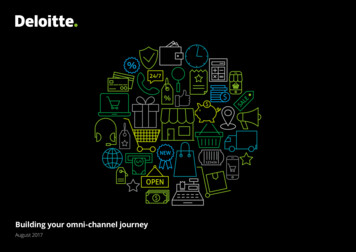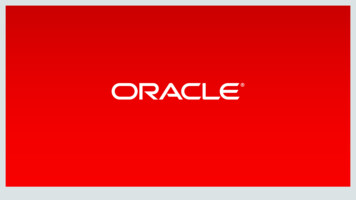
Transcription
Building your omni-channel journeyAugust 2017
You can’t just open a websiteand expect people to flood in.If you really want to succeed youhave to create traffic.Joel Anderson (Walmart CEO)
Point of vieweapcdsSierplupcapelandsDigitallanToday’s landscape is changing rapidly, affecting customer experienceCustomereexperiencChanging digital landscape Surge in internet trafficChanging supplier landscapeChanging customer experience Offering products via variouschannels simultaneously 24/7 connected and informed trough social network and communities Central infrastructure Higher and more diverse expectations than ever before Advanced technology systems Big data is big business Changing customer centric journey Advanced analytics Demanding increased personal and tailored shopping experience Redefining logistics to fulfillanywhere at anytime Introduction of new devices Explosion in mediaconsumption
Point of viewBrick-and-click retailers need to find a position between pure brick-and-mortar andpure digital, while competitors originating from both sides are moving to the centerYouFinding the optimal balanceOriginating brick-and-mortarOriginating pure digital Started from traditional retail background, adding digital on top Started from pure digital, adding brick operations to complement Focus on look-and-feel experience, lower breadth of assortment High breadth of assortment, less look-and-feel experience Physical presence, asset heavy Asset lean, less physical presence Fewer digital marketing requirements, consumer engagement from storedoorstep Consumer engagement from start of journey, more digital marketingrequirements Traditional retail operations, modular distribution network required High fulfilment service quality, granular distribution network required Batch size operations, fewer direct to consumer fulfilment possibilities Direct to consumer fulfilment, single piece operations Simple visibility capability requirements, less supply chain flexibility More supply chain flexibility, complex visibility capability requirements
Point of viewNavigating towards an omni-channel demand chainHistoricallyPhysical store“The customers will come to us”The pastE-commerce“We need to sell online” Location, assortment, and pricebased business model Attention and resources aimedat building an online ‘arm’ of thebusiness Supply chain efficiency focus Separate organizational structuresand P& L responsibility for newchannelThe recent pastMulti-channel “Many customers shop acrosschannels” Interdependent influencesbetween online and in-storesbecomes apparent Need to align retail execution withcustomer preferences highlightschannel specific processes,thinking, and metrics Customer expectations outpaceretail delivery modelThe presentOmni-channel“Relevant products and servicesanywhere” Connected consumersinteract physically and digitallyconcurrently Distinctions between channelsfade and profitability by channelproves elusive Customers’ desire to interactwherever and wheneverthey prefer drives dramaticacceleration of digital innovationThe futureEcosystem“Use ecosystem of products & services” Retailers use the networks ofall their partners and vendorsto seamlessly deliver “whatcustomers want, where they wantit, and when they want it”
Point of viewPositioning according to consumers desired journey across the fulfillment process,improves satisfaction and revenueCustomers expect personal and consistent cross-channel shoppingexperience throughout its customer journey at all timesDiscover & engageOrder Same service levels and access toinformation Possibility to order throughdifferent channels A high product variety acrossvarious channels To order from anywhere atanytime High levels of productcustomization through onlinechannels A variety of payment options Similar pricing across all channelsAvailability To view in store inventory availableonline Ease of use for mobile channels Products to be available at thetime of purchasing Brick-and-mortar as complementto online channel Seamless access to alternativestockDeliver Clear communication onestimated delivery date andshipping costs Free shipping options Ability to track purchases aftershipping Multiple and flexible deliveryoptions Faster deliveryBe served Clear returns policy Standard return free ofcharge and hassle-free Cross-channel returns Transparent customerservice Differentiated (self-) service
Point of viewThe pressure field for the supply chainTo bring consumer preferences to life, your supply chain will need to be re-evaluated in order to find the rightcapability trade-offs to support efficient standard fulfilment and responsive premium servicesEfficientEnabling capabilitiesResponsiveSupply chain capabilitiesCommercial capabilitiesEnd-to-end inventory visibilityCost optimized network footprintNetwork designOptimized tax routingsAsset efficiency of inventorydeployedInventory deploymentAnalytics and informationmanagementOrganizational andpartnership structuresSingle customer viewCost efficient push logistics andcost- to-serve fulfilmentReplenishment andfulfilmentReverse logisticsCost optimized returns processingService-optimized networkfootprintBreadth and depth of localassortmentResponsive pullreplenishment and dynamicfulfilmentIn-season returns reallocation
Point of view5 key capabilities to support the omni-channel ecosystem1Inventory optimizationLeveraging the ecosystem withone view on inventory acrossDelivery ascompetitive advantageBalancing key client serviceoptions regarding cost,speed and flexibility,offsetting operating coststhough an agile supply chain5Personalized fulfillmentOrder fulfillment aligned to customer needsregarding the way, shape or form goods are received3Learning supply chainSupporting agility in respondingto evolving customer needs4Seamless returnsSeamless experience andconvenience also in theafter-sale2
Point of viewKey value the omni-channel supply chain bringsEstablishing an omni-channel ecosystem can be a competitive differentiator and improve operating marginAn ecosystem of products and services can deliver “whatcustomers want, where they want it, and when they want it”Saving a saleRetailers can save sales by offering to get products to customers byshipping from the most efficient point in their ecosystem that has inventorySpeed of deliveryTraditional retailers can more effectively compete with digital retailers bycapitalizing on their ecosystem to improve delivery speedsOffset network capacity constraintsDistribution centers face capacity constraints during demand spikes thatcan be mitigated by fulfilling from stores, vendors or 3rd party partnersLost sales recovery potentialMaximize availability as consumer loyalty to sales channel is low“Up to 45% of lost sales can be saved by offering alternative availability in stock-out situations.”Willingness to pay for premiumLeverage willingness to pay for same day or other premium services“Up to 60% of consumers are willing to pay for same day delivery.”The importance of costsPursue strategy of free of charge delivery and return“Delivery and return costs are up to 12x more important than e.g. speed.”Inventory managementA view of inventory across the entire ecosystem allows retailers to optimizeand reduce overall stock levels by using all available inventory to fulfillordersMargin managementRetailers can improve margin management by balancing inventory acrosslocations with the highest demand to allow more products to be sold at fullprice
ApproachHow to get started?Getting to true omni-channel fulfilment requires you to think big, start small and connect now!Establish a consumer centered foundationIdentify your program leader and assemble a team to accelerate your omni-channel goals. Understand the value drivers that mobilize and engage yourorganization and partners to create a step-change in consumer satisfactionThink bigStart smallConnect nowEmbrace the consumer journeyPave the way towards a seamless end-to-end consumerjourney by understanding your consumer and theirexpectationsPrioritize your service offeringsPick priority fulfilment offerings, markets or cities tofocus on in order to get started and establish a proof ofconcept through agile design-thinkingtheir expectationsBreak-down the internal silosSupport omni-channel thinking: online depends onoffline and vice-versa. Integrated channels and supplychains are more resilient and competitiveDesign future proofEmbrace change and disruption in the marketplace.Design omni-channel fulfilment capabilities to withstandand exploit exponential technologies and otherdisruptionsFind the trade-offIdentify the trade-offs needed to support fulfilmentofferings and adhere to constraints of existingoperations. Avoid a total overhaul before success ismeasured on small scaleStrengthen your external networkEstablish partnerships with upstream and downstreamplayers. A network of organizations with partnerships willoutperform single firms
ApproachA multi-stage process to omni-channel executionDeloitte is well positioned to help analyze the current maturity of your organization and to define a setof initiatives in a short term by building an implementation plan to provide the path from the vision andstrategy to realization, and assess the implications to the operations, organization, and processes.ImagineIdeation & StrategyWhat is the art ofthe possible? Ideation Workshops Business Strategy Product Innovation Operational Improvement Business CaseDeliverRunPilot & RoadmapScale and DeployHow to turn a great ideainto an executable plan? Identify Minimum ViableProduct or OperationalImprovement Iterative pilot/rapid agileprototypes Develop ImplementationRoadmap Security and Privacy Strategy Organization and CapabilitiesGap AnalysisHow do I get it done? Architecture and System Design UI Development User stories Middleware & ApplicationDevelopment Security Requirements Change Management Analytics/Big Data Agile Testing LaunchOperateHow to make it hum? Business and TechnicalOperations Iterative Improvements
ApproachThe imagine phase as a low barrier entry approachImagineGreenhouse SessionMobilization andpreparationIdeation WorkshopDiscuss outcomes ofGreenhouse sessionand assess againstmarket study findingsMarket studyStudy performanceand strategies ofcompetitors and peersIndustry trendsKey trends and developments in theindustry and their impactToolsThe Deloitte Greenhouse serves asa facilitating environment to engageparticipants in thought experiments andbrainstorming nariosCapability assessmentDefine strategic Supply Chaincapabilities and identify gapsStrategyWorkshopSelectpreferredsupply chainstrategyscenariosPlanningWorkshopIdeation ofprojectstowardsOmni-channelexecutionBusiness caseHigh-level study ofbenefits and investmentsPrioritizedopportunities list andhigh-level roadmapDeliverablesAn omni-channel supply chain strategy that is aligned with the businessstrategyA list of concrete opportunities and best practices to go forwardA high-level roadmap that outlines the activities and projects to implementomni-channel supply chain strategy
Our learningsEssential key requirements based on our experienceMaintain Brick as complementary to Click42% of online consumers favors store and website evenly,while 32% values store most.Pursue strategy of free of charge deliveryDelivery cost is 3 to 6 times more important thane.g. speed. For return costs, the effect doubles.Strengthen mobile purchasing experienceDigitally savvy consumers favor mobile channels1.5 to 2 times more than the average consumer.Leverage willingness to pay for same day or otherpremium servicesUp to 60% of consumers is willing to pay for same daydelivery.DeliveryOrderingOrderingEnable payment after purchase53% of consumers prefer to receive productsbefore payment.OrderingMaximize availability as consumer loyalty to saleschannel is lowUp to 45% of lost sales can be saved by offeringAvailabilityalternative availability in stock-out situations.Exploit return channel as sales opportunityUp to 50% of consumers is open to suggestedadd-ons to their basket.Deliver upon the promise and shift focus toConsumer Lifetime ValueUp to 54% of consumers would not return after adisappointing fulfilment experience.Delivery & returnReturnAll areas
Our learningsOrganizations need to address multiple critical success factors in order to establisha successful omni-channel ecosystemEnterprise architecture: overcome incumbent complexityIT systems to enable logistics, inventory, warehousing, and correspondingmanagement processes need to be adapted and integratedGlobal vs. local: tailor standard solutionsProven end-to-end solutions are still limitedly available off-the-shelf. Enabling omnichannel offerings requires global solutions to be tailored to local market needsBreak-down silosSuccessful omni-channel organizations establish cross-functional collaboration and decisionmaking processes, as well as end-to-end visibility leveraging integrated data modelsCrack the partnership-casePartnerships between e-tailers, wholesalers and franchisees can be a game-changer.However, cannibalization risk, revenue recognition and tax constraints should be addressedDifferentiate: Find your profitable balanceNot all omni-channel offerings like Ship-from-Store, Click & Collect and Same day deliveryreach bulk volumes in the short term. It is key to smartly differentiate
Our omni-channel practiceDeloitte brings multiple capabilities together to build your E-commerce journeyStrategy & Market propositionFinancialsCustomer ExperienceOrganizational capabilitiesTax & LegalLogistics & Supply ChainIT & Security RequirementsStrategy & MarketpropositionStrategic aspirations& PositioningCustomer segmentsValue proposition &assortment strate
Consumer engagement from start of journey, more digital marketing requirements . Pursue strategy of free of charge delivery and return “Delivery and return costs are up to 12x more important than e.g. speed. ” Saving a sale Retailers can save sales by offering to get products to customers by shipping from the most efficient point in their ecosystem that has inventory Speed of .











